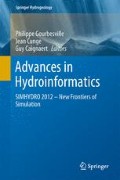Abstract
Monitoring drinking water is an important public health problem because the safe drinking water is essential for human life. Many procedures have been developed for monitoring water quality in water treatment plants for years. Monitoring of water distribution systems has received less attention. The goal of this communication is to study the problem of drinking water safety by ensuring the monitoring of the distribution network from water plant to customers. The system is based on the observation of residual chlorine concentrations which are provided by the sensor network. The complexity of the detection problem is due to the water distribution network complexity and dynamic profiles of water consumptions. The onset time and geographic location of water contamination are unknown. Its duration is also unknown but finite. Moreover, the residual chlorine concentrations, which are modified by the contamination, are also time dependent since they are functions of water consumptions Two approaches for detection are presented. The first one, namely the parametric approach, exploits the hydraulic model to compute the nominal residual chlorine concentrations. The second one, namely the nonparametric approach, is a statistical methodology exploiting historical data. Finally, the probable area of introduction of the pollutant and the propagation of the pollution are computed and displayed to operational users.
Access this chapter
Tax calculation will be finalised at checkout
Purchases are for personal use only
References
Hamam, Y., & Brameller, A. (1971). Hybrid method for the solution of piping networks. Proc IEE, 118(11), 1607–1612.
SAFEGE, Piccolo Modelling Guide. www.safege.fr.
Boulos, P., Altman, T., Jarrige, P. A., & Collevati, F. (1995). Discrete simulation approach for network water quality models. Journal of Water Resources Planning and Management, 1996, 49–60.
Jarrige, P. A. & Gancel, G. (2011). Inverse problem solving in water distribution networks. Proceedings of Computer and Control in the Water Industry (Vol. 11).
Castro, P., & Neves, M. (2003). Chlorine decay in water distribution systems case study-Lousada network. Electronic Journal of Environmental, Agricultural and Food chemistry, 2(2), 261–266.
Fillatre, L., & Nikiforov, I. (2010). A fixed size sample strategy for the sequential detection and isolation of non-orthogonal alternatives. Sequential Analysis, 29(2), 176–192.
Guepie, B., Fillatre, L. & Nikiforov, I. (2012). Sequential monitoring of water distribution network. In The Proceeding of the SYSID 2012, 16th IFAC Symposium on System Identification, Brussels, Belgium, 2012 July 11–13.
Tax, D. (2001). One-class classification. Ph. D Thesis, Delft University of Technology, Delft.
Schölkopf, B., Platt, J. C., Shawe-Taylor, J., Smola, A. J., & Williamson, R. C. (2001). Estimating the support of a high-dimensional distribution. Neural Computation, 13(7), 1443–1471.
Ratle, F., Kanevski, M., Terrettaz-Zufferey, A.-L., Esseiva, P. &Ribaux, O. (2007). A comparison of one-class classifiers for novelty detection in forensic case data. In Proceedings 8th International Conference on Intelligent Data Engineering and Automated Learning (pp. 67–76). Berlin, Heidelberg: Springer.
Honeine, P., Richard, C. & Bermudez, J. C. M. (2007). On-line nonlinear sparse approximation of functions. In Proceedings IEEE International Symposium on Information Theory, Nice, France (pp. 956–960).
Honeine, P., Richard, C., Bermudez, J. C. M. & Snoussi, H. (2008). Distributed prediction of time series data with kernels and adaptive filtering techniques in sensor networks. In Proceedings 42nd Annual ASILOMAR Conference on Signals, Systems and Computers, Pacific Grove, CA, USA, invited paper.
Richard, C., Bermudez, J. C. M., & Honeine, P. (2009). Online prediction of time series data with kernels. IEEE Transactions on Signal Processing, 57(3), 1058–1067.
Bakhache, B., & Nikiforov, I. (2000). Reliable detection of faults in measurement systems. International Journal of Adaptive Control and Signal Processing, 14(7), 683–700.
Author information
Authors and Affiliations
Corresponding author
Editor information
Editors and Affiliations
Rights and permissions
Copyright information
© 2014 Springer Science+Business Media Singapore
About this chapter
Cite this chapter
Noumir, Z. et al. (2014). Detection of Contamination in Water Distribution Network. In: Gourbesville, P., Cunge, J., Caignaert, G. (eds) Advances in Hydroinformatics. Springer Hydrogeology. Springer, Singapore. https://doi.org/10.1007/978-981-4451-42-0_12
Download citation
DOI: https://doi.org/10.1007/978-981-4451-42-0_12
Published:
Publisher Name: Springer, Singapore
Print ISBN: 978-981-4451-41-3
Online ISBN: 978-981-4451-42-0
eBook Packages: Earth and Environmental ScienceEarth and Environmental Science (R0)

